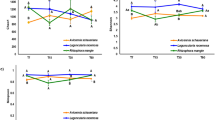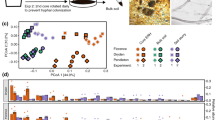Abstract
WE would like to direct attention to the remarkable similarity between the composition of the micro-fungal population of some acid sandy podsol soils in England, as recorded by Jeffreys, Brian, Hemming and Lowe1, and that of some acid podsol soils in Victoria, Australia2. This similarity is associated with the presence in the B-horizon of what is described as an iron-pan in the English soils.
This is a preview of subscription content, access via your institution
Access options
Subscribe to this journal
Receive 51 print issues and online access
$199.00 per year
only $3.90 per issue
Buy this article
- Purchase on Springer Link
- Instant access to full article PDF
Prices may be subject to local taxes which are calculated during checkout
Similar content being viewed by others
References
Jeffreys, E. G., Brian, P. W., Hemming, H. G., and Lowe, D., J. Gen. Microbiol., 9, 314 (1953).
McLennan, Ethel I., and Ducker, Sophie C., Aust. J. Bot., 2, 220 (1954).
Linnemann, G., “Die Mucorineen-Gattung Mortierella Coemans” (Gustav Fischer, Jena, 1941).
Author information
Authors and Affiliations
Rights and permissions
About this article
Cite this article
McLENNAN, E., DUCKER, S. Micro-fungal Population of Acid Sandy Podsols. Nature 174, 1060–1061 (1954). https://doi.org/10.1038/1741060b0
Issue Date:
DOI: https://doi.org/10.1038/1741060b0
This article is cited by
-
Ecology of Mucor ramannianus Moller
Nature (1959)
Comments
By submitting a comment you agree to abide by our Terms and Community Guidelines. If you find something abusive or that does not comply with our terms or guidelines please flag it as inappropriate.



